Set your alarms for tomorrow, March 20, 2025, 9.01 AM (UK) to welcome the new day and year (vernal equinox) with a happy heart & home.
As I mentioned in the first part, we didn’t have set days, months, or weeks; rather, our forebears likely held communal celebrations to observe nature’s return to life. Now, we can pinpoint the exact moment our planet begins its new journey around the sun. All those who observe Nowruz Bayrami set a table with symbolic items, arranged with joy, care, and love, whether on a simple napkin or a grand table. Many such tables are being laid all over the world as I type this. Each item holds meaning for humanity and is honored by its presence at the moment of our planet’s new revolution around the sun. This marks the first day of yas, spring,in the Northern Hemisphere.
We don’t know when, why, how, or what our ancestors placed on their tables, cloths, or altars, nor do we know the precise meanings they attached to these items. But I will share my findings and interpretations with you.
I don’t believe there was ever a fixed number of items, yet seven seems to have been sacred to our forebears. The mystical ۷ / 7 appears in ancient beliefs, stories, and both pagan and world religious texts. This may be linked to the Sumerian sexagesimal number system. Either way, across much of the world, seven was (and still is) considered a lucky number, though not everywhere. For example, in Mongolia, China, and other regions, it is actually seen as unlucky!
In the Zoroastrian faith and some Turkic stories, part of our oral tradition, the number seven appears frequently. For instance, in the story of دده قورقود, Dada Gorgoot, it represents the number of tribes, paths, and dragon heads, among other things.
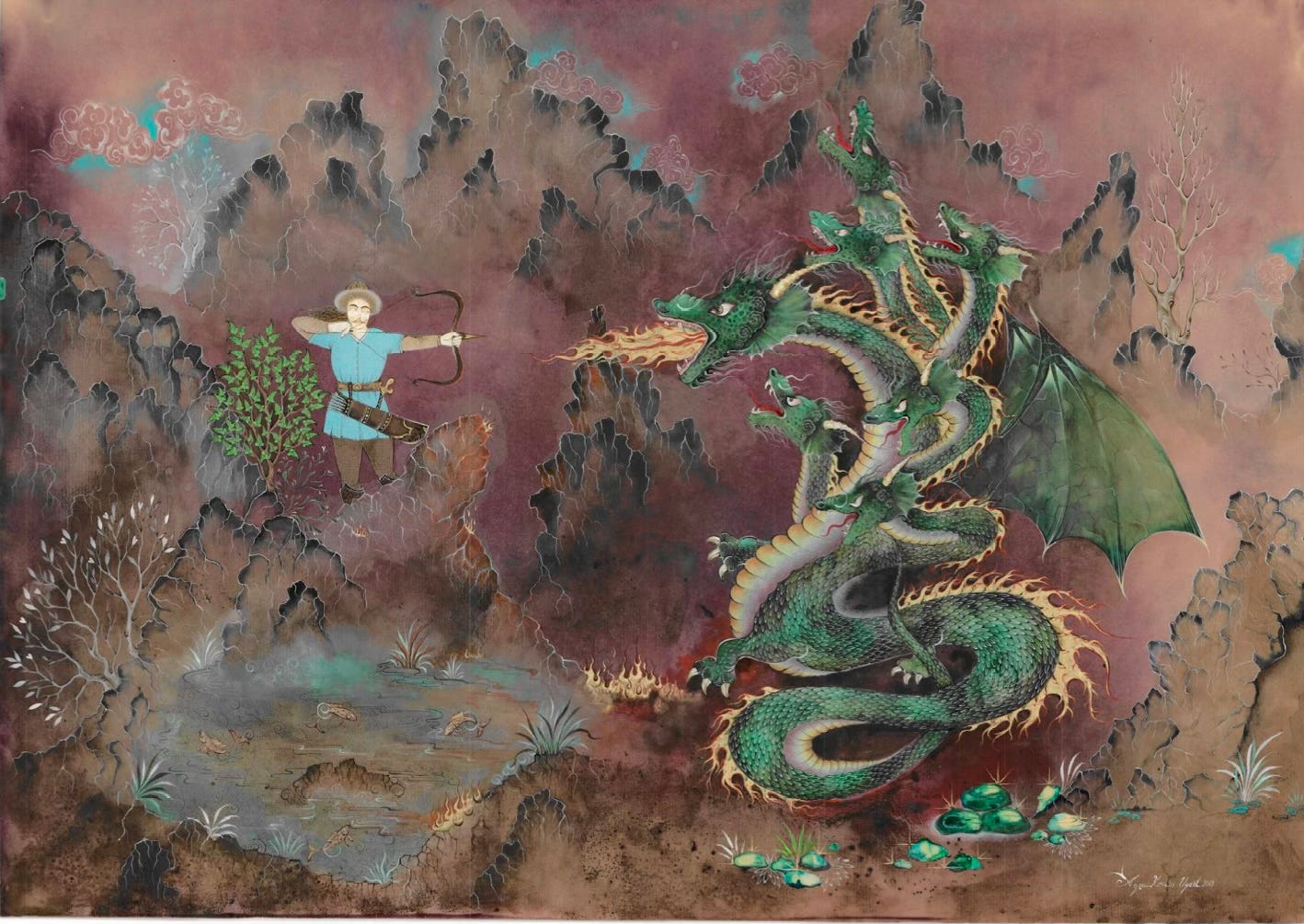
With its positive associations, it is understandable that it would have been included in Nowruz customs. Having seven items may have been believed to increase the chances of good health, a bountiful harvest, and prosperity. This is taken a step further in Iranaian speaking regions, where the table is now called Haft Seen (the Seven "S's").
There are three different "S" in the Iranian alphabet: س ,ص and ث. Starting with س (siin): سیر (seer – garlic), سنجد (senjed – oleaster), سرکه (serkeh – vinegar), سماق (somagh – sumac), سمنو (samanu), سبزه (sabzeh – sprouts), and سیب (sib – apple) and an extra one (sonbol - hyacinth) سُنبُل.
Some suggest that siin comes from the Iranian word for tray, siini, which later transformed into siin. Trays are widely used, not just for serving tea but for cleaning grains, as individual meal settings, for transporting items, and, of course, for ceremonial displays. Shiny metallic trays may also have symbolized gifts from the sun.
Nowadays, Iranian Azeris commonly call it Haft Siin Sufrasi, but I've also heard it called Yedi Barachat (Seven Blessings). Moreover, in Azeri, not all of these items start with the letter siin, and before literacy, it’s unlikely that people in Iran would have been aware of different "S" letters. I’ve looked but haven’t found any reference to dairy, which is surprising given that it was such an important food for the people of this area? In September, my book Fermented Dairy of Central Asia will be published, for that reason I included kefir and gooroot on my table.
Incidentally, my name, سیمین , an adjective for the colour of the moon or silver. My mother joke when I was little that if she was short one siin, she could put me on the table!
In some families, items such as eggs, apples, and coins are placed in numbers matching the number of children in the home. Most likely, this was originally for the practical reason of sharing equally.
The meanings behind the items are similar, though interpretations vary by country and even by household. Here are the most common things on our sufra and some of their associated meanings. You’ll notice that the plants are all native to the region and that there’s a universality to the explanations. This is because, through trade, travel, and conquest, they were borrowed, shared and even claimed.
I’ll start with the four elements:
Air, wind and sky: Represented by a reflective surface such as still water, a tray or mirror. It can be a reminder for self-reflection, purity and honesty.
Water: A jug of water, or many containers of water around the house, a fish in a bowl of water. These symbolise the importance of water for life and, for some, either the astronomical or zodiacal sign of Pisces.
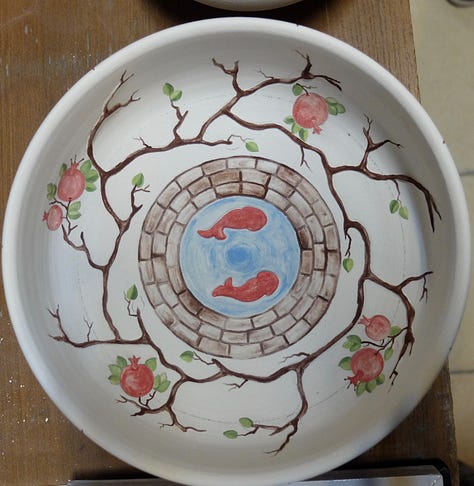

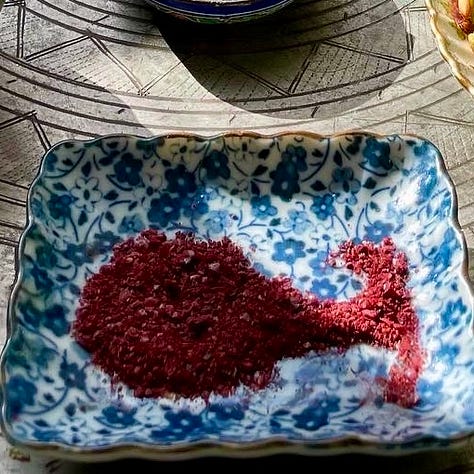
Soil: Is represented by many things listed below:
Toasted wheat or lentils a snack known as govurga or Sumani. It represents patience and perseverance, which is required in making it.
Sprouted micro-greens which grow daily representing the greening of the land and rejuvenation of nature. Almost anything can be sprouted, seeds like flax, mustard, cumin and coriander, grains and legumes. Garlic for both its health giving properties and its smell to ward off evil.

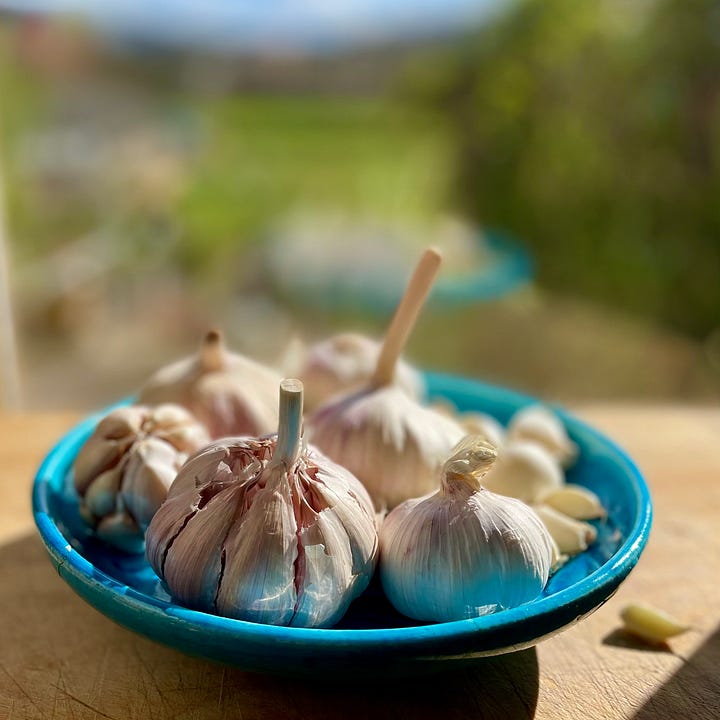
Trees with red leaves, fruits and seeds. Red is a khosh yum or lucky colour, a red apple for beauty, knowledge and health. Sumac with its ruby seeds to represent the sun and joy. Our Rhus trees are a blaze of red in the autunm.
The fruit of the oleaster tree ida in Azeri. Nutritious and a symbol of love. The scent of their blossoms so intoxicating they arouse passions and lust.
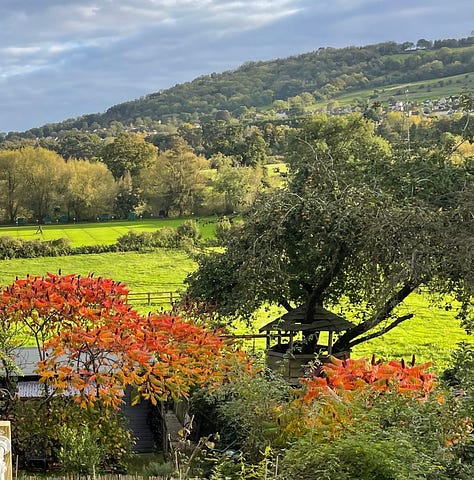
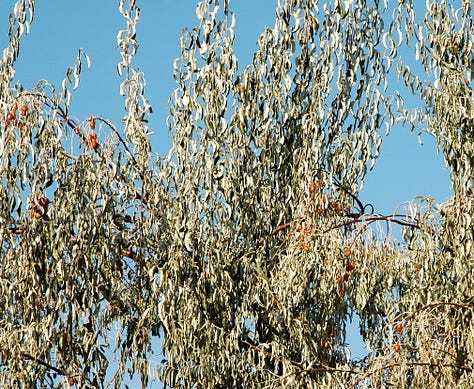

Wine or post Islam, vinegar, both are aged and represent the wisdom that comes with age. Heavenly scented hyacinth to bring the scent of spring. I have also seen bread which is an important staple and no dining table is complete without it. Wild rue, uzarrih, which is burned to disinfect the air and or ward off bad eye and rice, a more recent addition.
Fire: A burning candle or coal represents the sun, the giver of life, warmth, and comfort.
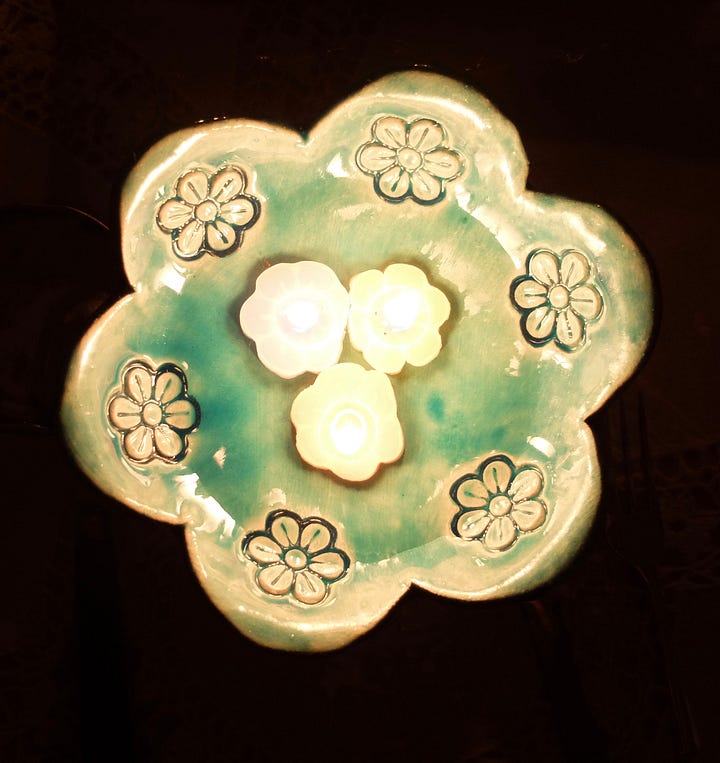
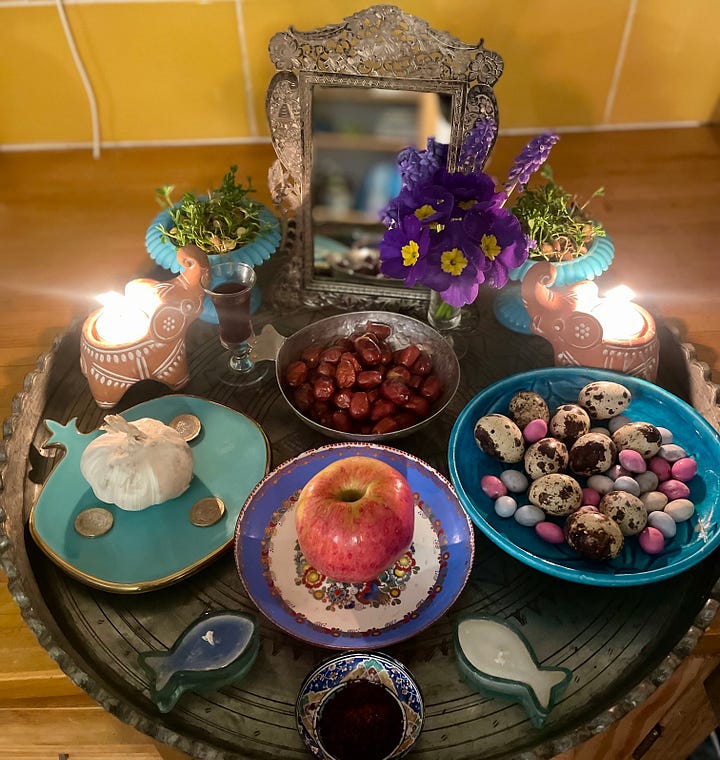
Animal: Decorated or dyed eggs represent humans, animals, fertility and life.
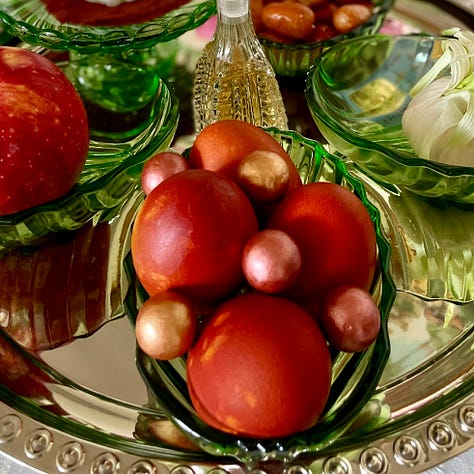

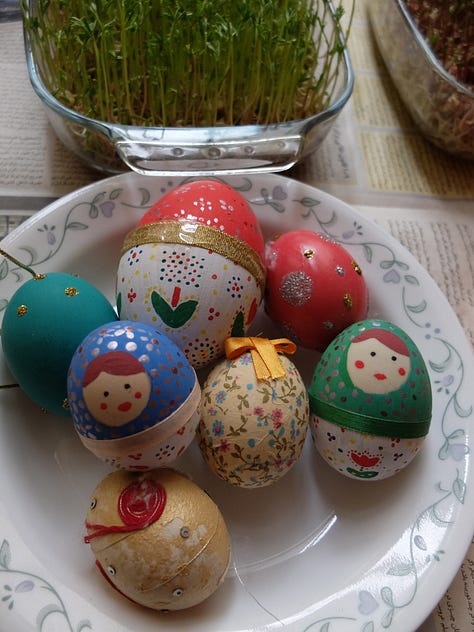
Coins: Allish verish or buying and selling, trade, abundance and prosperity.
Book: Representing knowledge and learning.
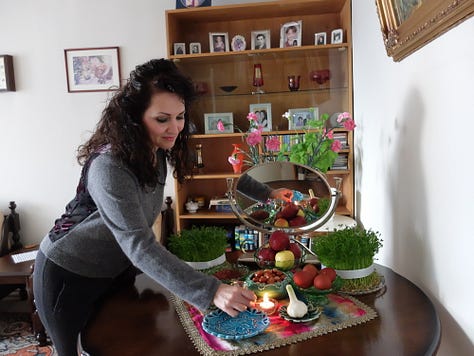
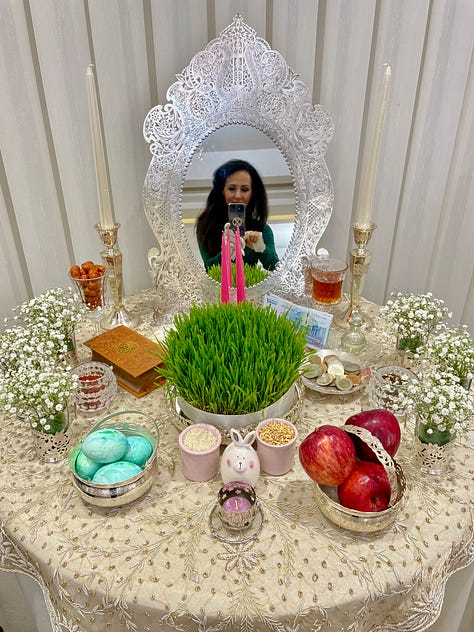

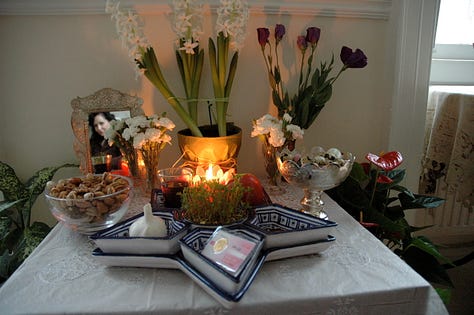
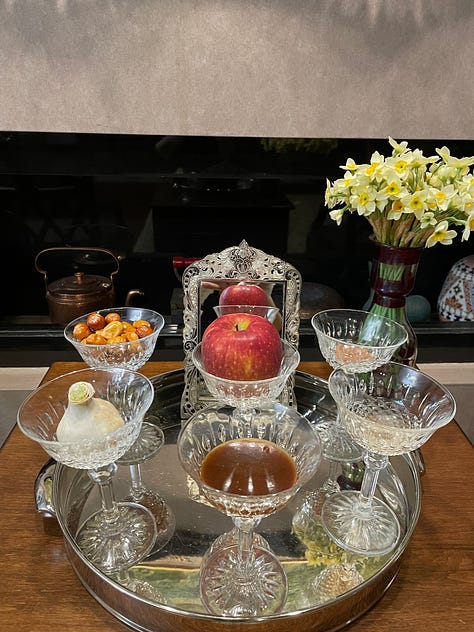
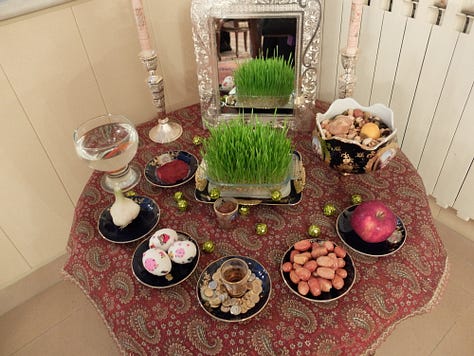

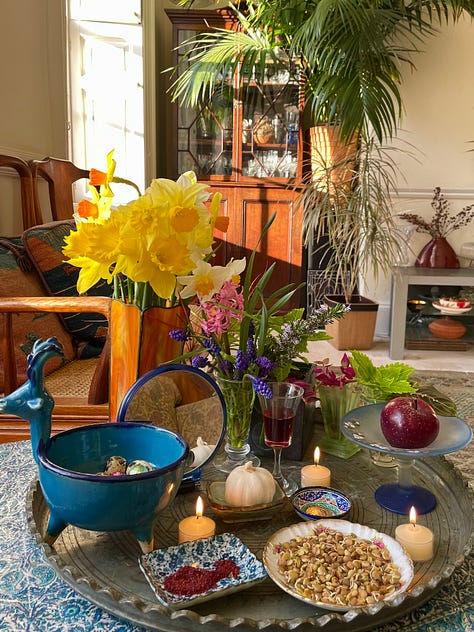
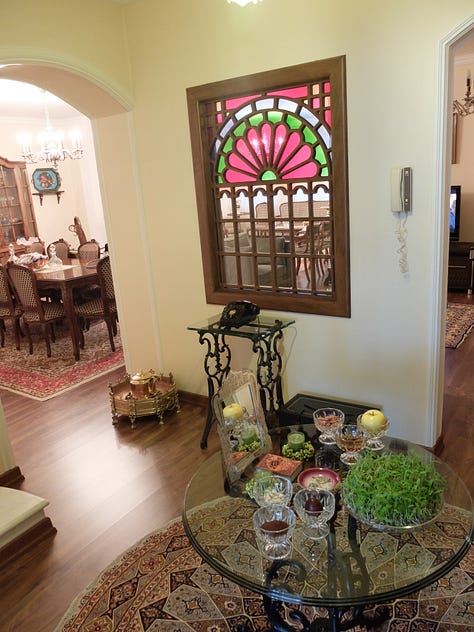
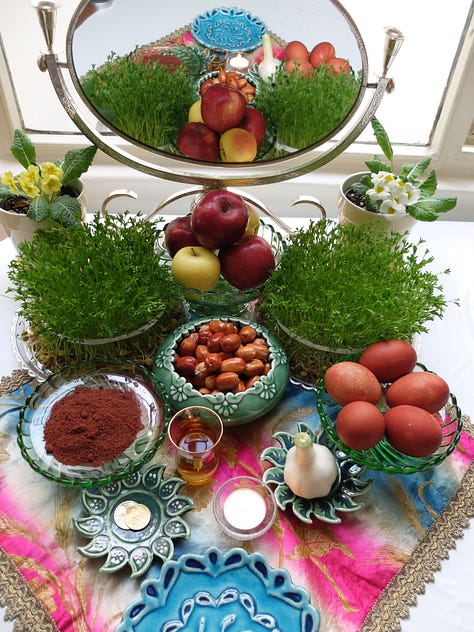
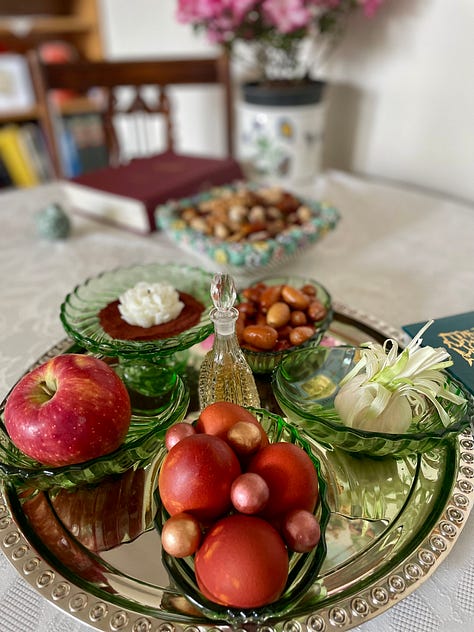
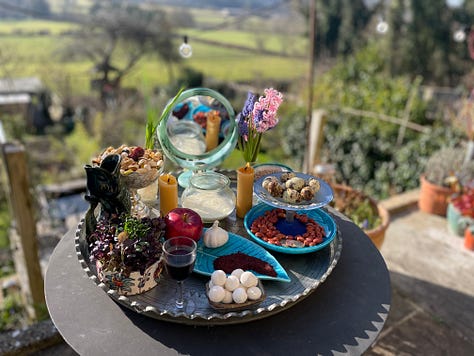
Depending on the time of day of the equinox, we are all dressed up, the chai is on, and we are either with family in person or virtually, with joy in our hearts and homes, welcoming the new day. However, if the equinox is in the middle of the night—like last year at 3:06 AM—then we just get up 15 minutes before, wash our faces, put on new clothes, light the candle, wish each other a happy new year, and return to bed.
At the moment of the equinox, or il donar, year turns in Turkic, which in Iranian, is now known as tahvil. This is an Arabic word with many meanings, such as transfer, conversion, and transformation. We count down to it and wish each other a happy new year.
The eldest in the family gives sufta, new money, from inside a great book as a gift. We then drink chai, eat something sweet, and some of us might pop corks. Then we either take selfies to post on social media to wish distant friends and family a happy new year or have virtual gatherings with loved ones around the world.
I mentioned in a previous post that, this year, with it being orushlukh (the month of fasting), visitors will come after breaking their fast. As a result, there may be fewer visitors, and we will serve zulbia and bamia (usually eaten at Ramazon) alongside the usual sweetmeats.
Over the next 12 days and nights, people make jorush, short visits to family and friends or going on holiday. These visits start with the eldest in the family and those recently bereaved, ending with visits to the homes of newlyweds.
Children are given money and coloured eggs from the table. Some play a game similar to conkers called doushdur(meaning "fight"), where one holds an egg while another cracks his against it. The unbroken egg wins, and the victor keeps both!
My mother usually receives visitors on the second day—one year, we had 90 visitors in total! She makes lunch for at least 20, not knowing if it is just her or if visitors coming around lunch time would like to stay for lunch as well. They usually do. This is a chance to take off our high heels, refill the platters with cakes and fruit, make fresh chai ready to see more friends and family.
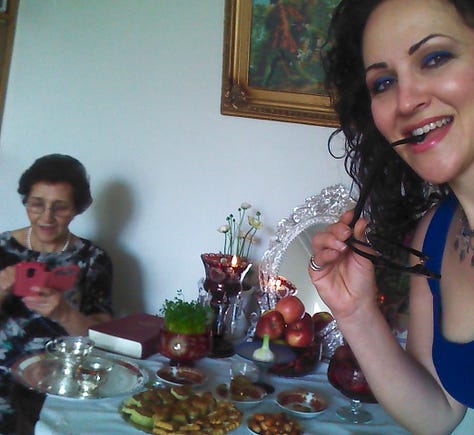
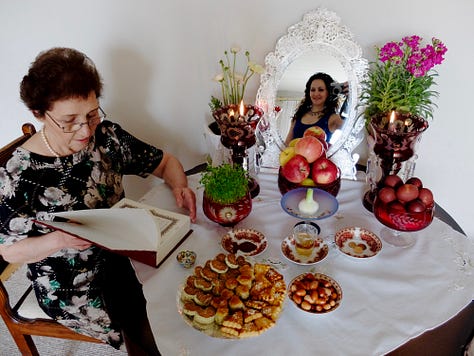
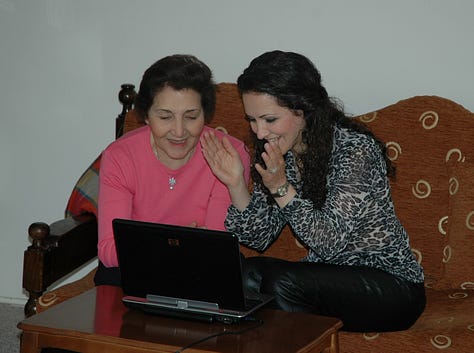
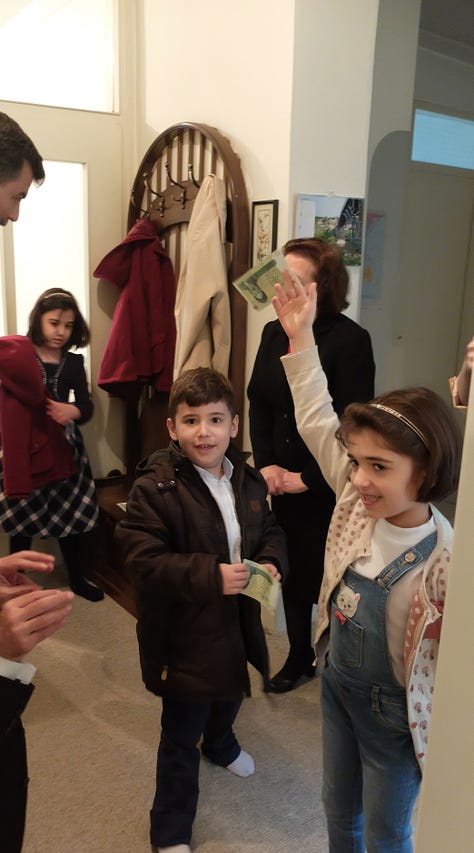
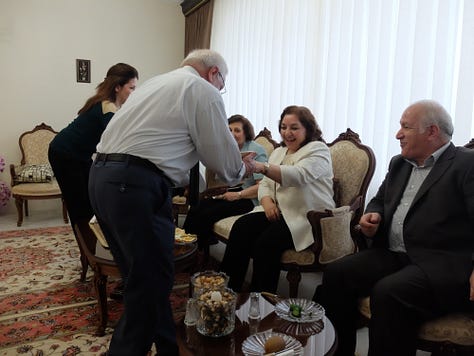
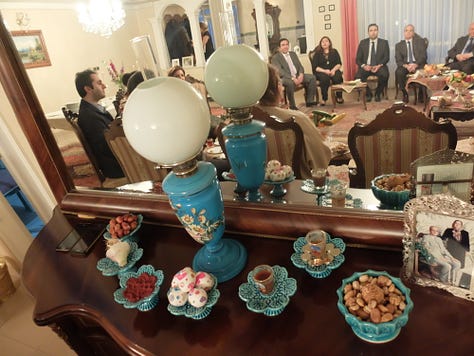
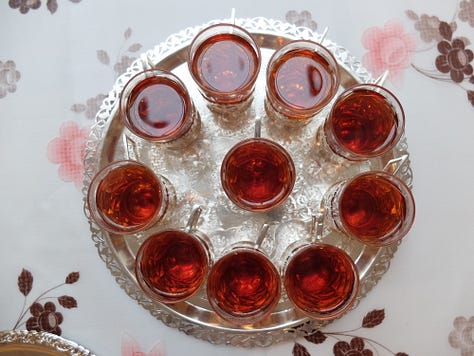
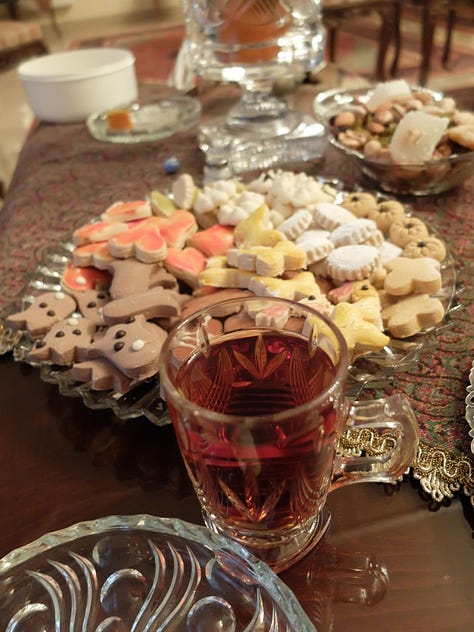
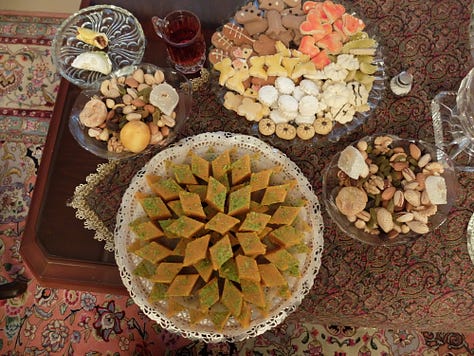
In Azerbaijan we have yarpokh dolmasi (vine leaf dolma) on Nowruz Bayrami. in Iran it is also customary to have Sabzi Polow, herb and garlic infused rice, served with fish, all of which are symbolic items from the Haft Siin. Probably eaten for iftar this year.
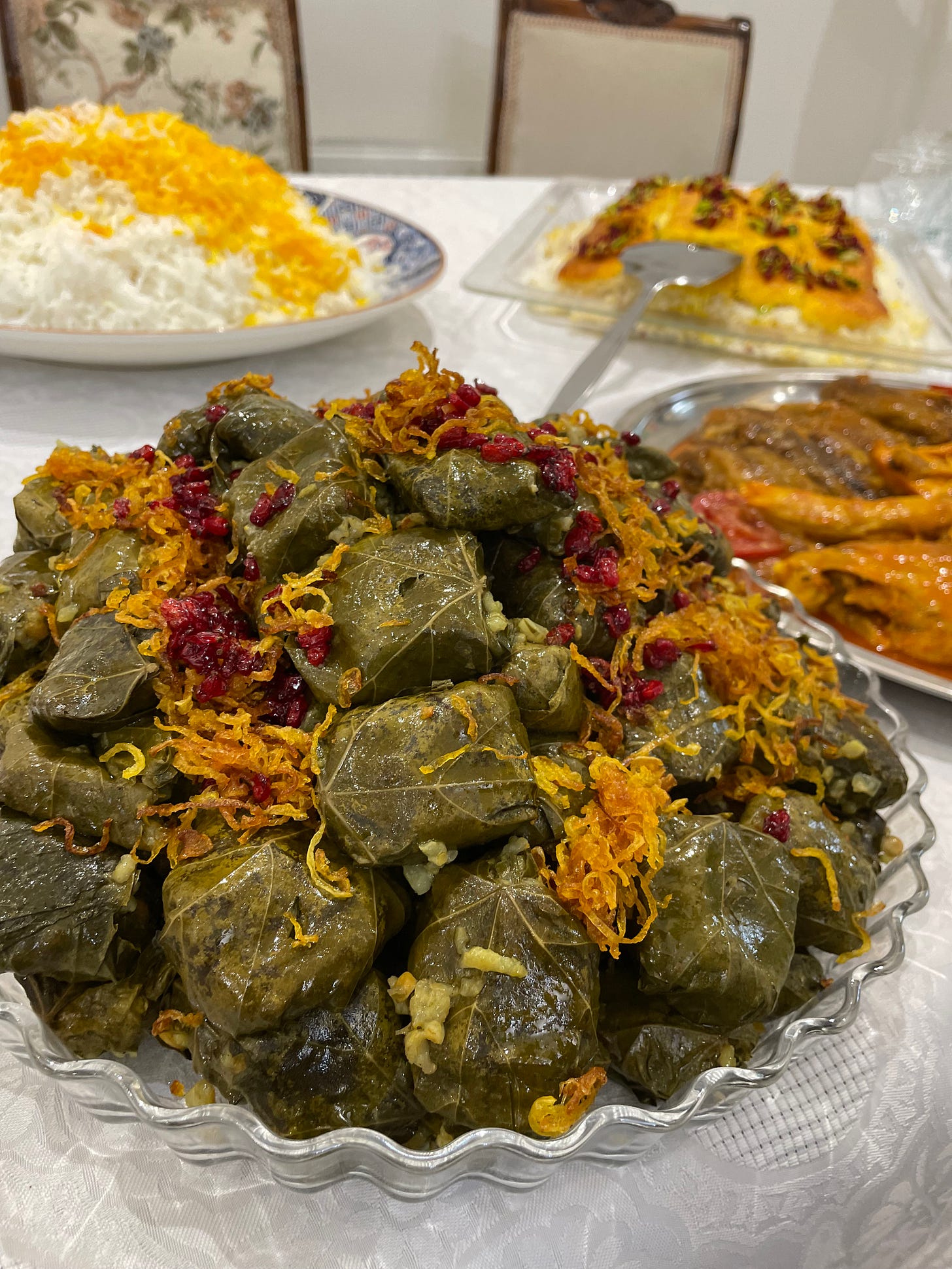
Tomorrow the first day of the year in Iran will be on Panjshanbeh (equivalent of our Friday eve ie day before weekend) 1 / 1/ 1404.
Thank you for reading about these traditions and I’d love to hear about your seasonal traditions.
With this, I wish us and our planet a happy and healthy Nowruz Bayrami.
I’m off to celebrate, starting with breakfast with my Baghdadi, AKA Amal, then jorush. I’ll be back on the “unlucky” thirteenth day of the new year to wrap up these celebrations.




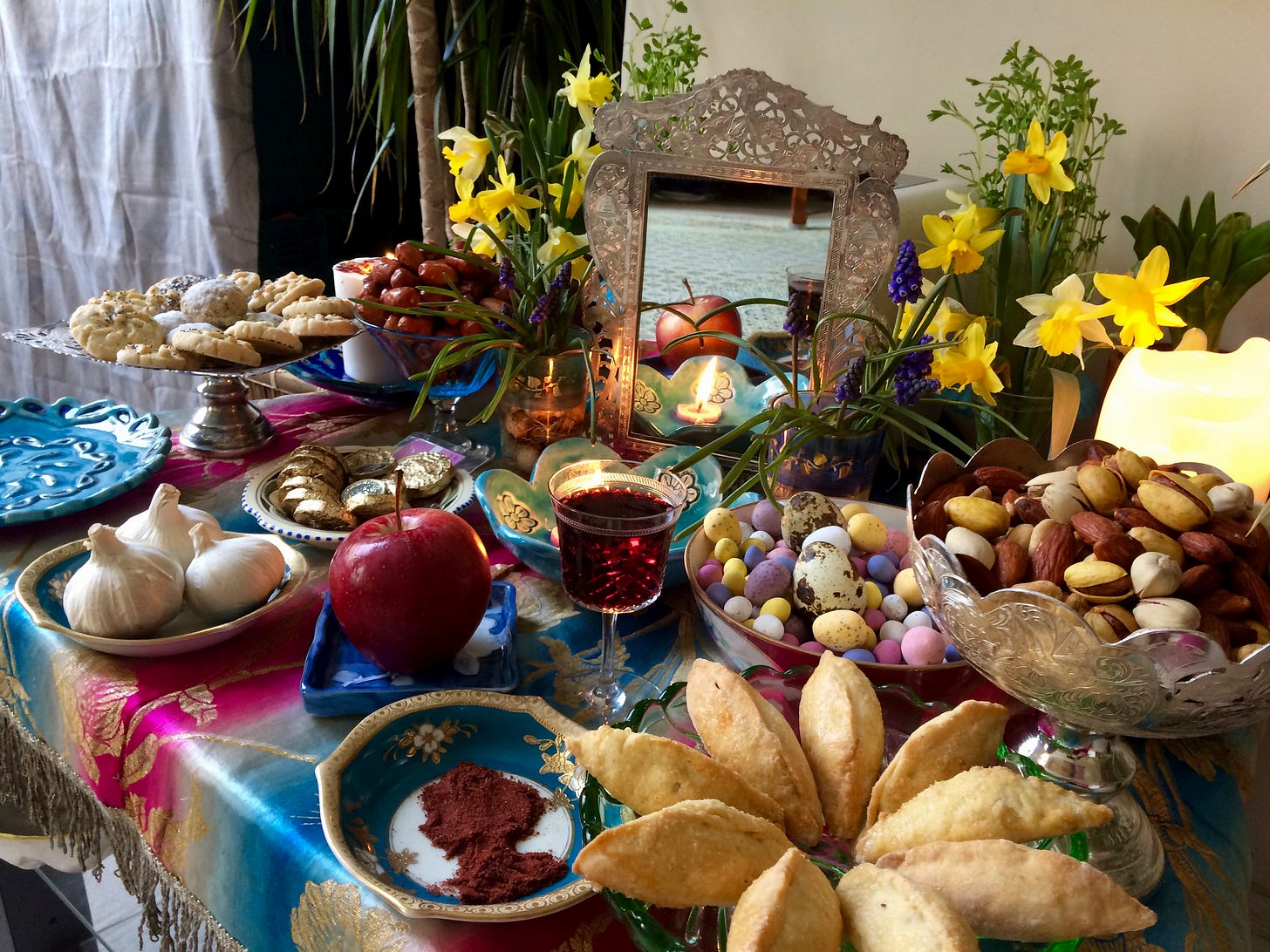
fascinating, Simi - and such beautiful presentations!